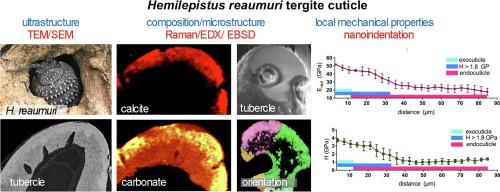Journal of Structural Biology ( IF 3.0 ) Pub Date : 2020-07-07 , DOI: 10.1016/j.jsb.2020.107570 Franziska Ernst 1 , Helge-Otto Fabritius 2 , Erika Griesshaber 3 , Christian Reisecker 4 , Frank Neues 5 , Matthias Epple 5 , Wolfgang W Schmahl 3 , Sabine Hild 4 , Andreas Ziegler 1

|
To survive in its extreme habitat, the cuticle of the burrowing desert isopod Hemilepistus reaumuri requires properties distinct from isopods living in moist or mesic habitats. In particular, the anterior tergites are exposed to high mechanical loads and temperatures when individuals guard the entrance of their burrow. We have, therefore, investigated the architecture, composition, calcite texture and local mechanical properties of the tergite cuticle, with particular emphasis on large anterior cuticle tubercles and differences between the anterior and posterior tergite. Unexpectedly, structure and thickness of the epicuticle resemble those in mesic isopod species. The anterior tergite has a thicker endocuticle and a higher local stiffness than the posterior tergite. Calcite distribution in the cuticle is unusual, because in addition to the exocuticle the endocuticle distally also contains calcite. The calcite consists of a distal layer of dense and highly co-oriented crystal-units, followed proximally by irregularly distributed and, with respect to each other, misoriented calcite crystallites. The calcite layer at the tip of the tubercle is thicker relative to the tubercle slopes, and its crystallites are more misoriented to each other. A steep decrease of local stiffness and hardness is observed within a distal region of the cuticle, likely caused by a successive increase in the ACC/calcite ratio rather than changes in the degree of mineralisation. Comparison of the results with other isopods reveals a much lower ACC/calcite ratio in H. reaumuri and a correlation between the degree of terrestriality of isopod species and the magnesium content of the cuticle.
中文翻译:

沙漠等足类动物 Hemilepistus reaumuri 的 tergite 角质层的功能适应性(Milne-Edwards,1840)。
为了在其极端栖息地中生存,穴居沙漠等足类动物Hemilepistus reaumuri的角质层需要与生活在潮湿或中等栖息地的等足类动物不同的特性。特别是,当人们守卫他们的洞穴入口时,前白蚁会暴露在高机械负荷和温度下。因此,我们研究了 tergite 角质层的结构、成分、方解石质地和局部机械性能,特别强调了大的前角质层结节以及前后 tergite 之间的差异。出乎意料的是,上表皮的结构和厚度与中等等足类动物的相似。前 tergite 具有比后 tergite 更厚的内皮和更高的局部刚度。角质层中方解石的分布是不寻常的,因为除了外角质层外,内角质层远端还含有方解石。方解石由致密且高度共取向的晶体单元的远端层组成,近端是不规则分布且相对于彼此错误取向的方解石微晶。结节尖端的方解石层相对于结节斜面更厚,其微晶彼此之间的取向更差。在角质层的远端区域观察到局部刚度和硬度的急剧下降,这可能是由 ACC/方解石比率的连续增加而不是矿化程度的变化引起的。与其他等足类动物的结果比较显示,在 结节尖端的方解石层相对于结节斜面更厚,其微晶彼此之间的取向更差。在角质层的远端区域观察到局部刚度和硬度的急剧下降,这可能是由 ACC/方解石比率的连续增加而不是矿化程度的变化引起的。与其他等足类动物的结果比较显示,在 结节尖端的方解石层相对于结节斜面更厚,其微晶彼此之间的取向更差。在角质层的远端区域观察到局部刚度和硬度的急剧下降,这可能是由 ACC/方解石比率的连续增加而不是矿化程度的变化引起的。与其他等足类动物的结果比较显示,在H. reaumuri以及等足类动物的陆生程度与角质层镁含量之间的相关性。









































 京公网安备 11010802027423号
京公网安备 11010802027423号